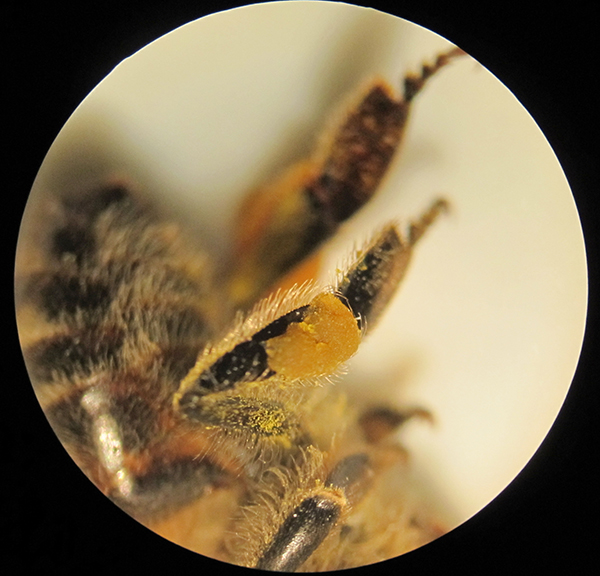Yes folks, it's CORBICULA TUESDAY! What's a corbicula? Well, it's the pollen "basket" either hind leg of a honey bee! It's a smooth spot surrounded by hairs. The bee packs pollen into the corbicula on each leg, and when she has a full load, she flies home.
Now this poor soul...
...had a nice load of pollen but never made it home. I found her dead on the ground outside her hive, pollen still clinging to her legs. Worker bees do many jobs in the hive, and their last one is to be a field bee, the time when she goes out to forage for pollen and nectar. Many bees simply drop dead while out on a foraging trip; by this time in their lives, they are quite old. Their wings are often tattered, their thorax worn smooth and hairless from work.
She worked hard until the very end.
Pollen also clings to the hair on the bees body. Sometimes you'll see a honey bee completely coated in yellow! But not all pollen is yellow. It comes in a range of colours. The other day I saw a bee bringing in blue pollen, likely from the Scilla Siberica in our garden! These are the flowers you see around here in spring that are reminiscent of English bluebells.
Poor little bee! But that's the way life is for the girls of apis mellifera.
I hope she wouldn't have minded me sticking her under my microscope...
As you can see, even the bees eyeball is hairy! Honey bees have two large compound eyes, and three small eyes (called ocelli) on top of her head. The ocelli only sense light,
Here's the reverse side of the leg packed with pollen. As you can see, there is a lot of that yellow gold stuck to her leg!
The other leg had less pollen. I suspect most of the load fell off when she hit the ground.
There's something a little sad about a honey bee working so hard for her hive, only to drop dead before she can bring home her bounty. Lucky for the hive, there are thousands more bees where this one came from!
Today's Alex offering:










That was fascinating. Now I have to learn the new words and drop them into conversation as though I have been using them for years.
ReplyDeleteJane x
Sooo cool! I love all your close up shots, you can really see everything so well. I was curious as to how the pollen "baskets" worked so I enjoyed reading this and learned something new!
ReplyDeleteWondrous and metaphorical and moving. Purpose and pointlessness all pulled together, all the way from cells, to bees, and us. A glorious post Knatolee.
ReplyDeleteBy the way, Alex's paw is scaring me. Have you been feeding him steroids?
Bees are beautiful!
ReplyDeleteYour photos are lovely but I am a little disturbed about the death...
ReplyDeleteI am very fond of bees :-)
http://cherryelsewhere.wordpress.com/2011/07/15/hello-world/
There is something so noble about the life and death of a honey bee.
ReplyDeleteInteresting account of the end of a bee's life. It takes many bees to produce all the honey we want from them.
ReplyDeleteVery interesting - thanks for the bee lesson - CherryPie should be disturbed about the bee death - I'm hoping that the State of Washington will follow the EU and ban some bee-unfriendly pesticides. We need to keep all the bees we can! T.
ReplyDeleteI want to see that neonicontinoid ban here too!!! On the bright side, this bee probably just perished from old ages. If this were a pesticide death, there would be a large PILE of bees like this in front of my hive! :( (Plus no one is spraying pesticide around here right now.)
DeleteRIP poor little bee!
ReplyDeletePoor wee thing. One of nature's most generous creatures.
ReplyDeleteWe should all follow the bee's example: being productive until our wings are tattered and our thoraxes (or thoraces) are smooth and hairless. :)
ReplyDelete